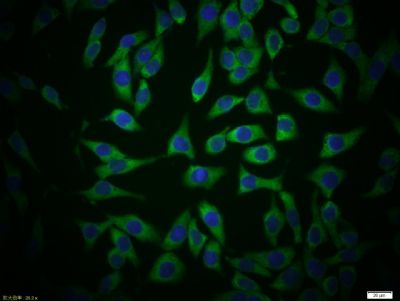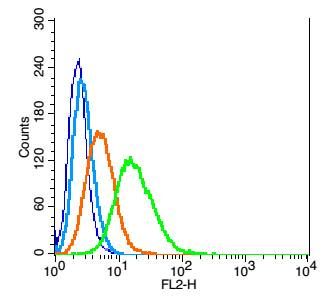产品中心
当前位置:首页>产品中心Anti-ERG/KCNH2
货号: bs-1815R 基本售价: 780.0 元 规格: 50ul
- 规格:50ul
- 价格:780.00元
- 规格:100ul
- 价格:1380.00元
- 规格:200ul
- 价格:2200.00元
产品信息
- 产品编号
- bs-1815R
- 英文名称
- ERG/KCNH2
- 中文名称
- 特异性钾离子通道蛋白抗体
- 别 名
- ERG; ERG1; H ERG; HERG 1; HERG; HERG1; LQT 2; LQT2; Potassium channel HERG; SQT1; Voltagegated potassium channel, subfamily H, member 2; KCNH2_HUMAN.

- Specific References (1) | bs-1815R has been referenced in 1 publications.[IF=5.90] Zhao, Jing, et al. "Chronic obstructive sleep apnea causes atrial remodeling in canines: mechanisms and implications." Basic Research in Cardiology 109.5 (2014): 1-13. WB ; Dog.PubMed:25015734
- 规格价格
- 50ul/780元购买 100ul/1380元购买 200ul/2200元购买 大包装/询价
- 说 明 书
- 50ul 100ul 200ul
- 研究领域
- 肿瘤 免疫学 细胞周期蛋白 通道蛋白
- 抗体来源
- Rabbit
- 克隆类型
- Polyclonal
- 交叉反应
- Human, Mouse, Rat, Dog, Pig, Horse, Rabbit,
- 产品应用
- ELISA=1:500-1000 Flow-Cyt=1μg /test ICC=1:100-500 (石蜡切片需做抗原修复)
not yet tested in other applications.
optimal dilutions/concentrations should be determined by the end user.
- 分 子 量
- 127kDa
- 细胞定位
- 细胞膜
- 性 状
- Lyophilized or Liquid
- 浓 度
- 1mg/ml
- 免 疫 原
- KLH conjugated synthetic peptide derived from human HERG:1001-1159/1159 <Cytoplasmic>
- 亚 型
- IgG
- 纯化方法
- affinity purified by Protein A
- 储 存 液
- 0.01M TBS(pH7.4) with 1% BSA, 0.03% Proclin300 and 50% Glycerol.
- 保存条件
- Store at -20 °C for one year. Avoid repeated freeze/thaw cycles. The lyophilized antibody is stable at room temperature for at least one month and for greater than a year when kept at -20°C. When reconstituted in sterile pH 7.4 0.01M PBS or diluent of antibody the antibody is stable for at least two weeks at 2-4 °C.
- PubMed
- PubMed
- 产品介绍
- background:
The potassium voltage gated channel, subfamily H (eag related), member 2 (KCNH2) gene encodes a voltage-gated potassium channel which has an important role in cardiac action potential repolarization in the mammalian heart. Mutations in KCNH2 have been shown to cause chromosome 7-linked congenital long QT syndrome, a disorder associated with delayed cardiac repolarization, prolonged electrocardiographic QT intervals, and the development of ventricular arrhythmias. KCNH2 channels are an important target for many drugs, and have emerged as a significant type of cardiac ion channel.Highly expressed in heart and brain.
Function:
Pore-forming (alpha) subunit of voltage-gated inwardly rectifying potassium channel. Channel properties are modulated by cAMP and subunit assembly. Mediates the rapidly activating component of the delayed rectifying potassium current in heart (IKr). Isoform 3 has no channel activity by itself, but modulates channel characteristics when associated with isoform 1.
Subunit:
The potassium channel is probably composed of a homo- or heterotetrameric complex of pore-forming alpha subunits that can associate with modulating beta subunits. Heteromultimer with KCNH6/ERG2 and KCNH7/ERG3. Interacts with ALG10B (By similarity). Heteromultimer with KCNE1 and KCNE2.
Subcellular Location:
Membrane; Multi-pass membrane protein.
Tissue Specificity:
Highly expressed in heart and brain.
Post-translational modifications:
Phosphorylated on serine and threonine residues. Phosphorylation by PKA inhibits ion conduction.
DISEASE:
Defects in KCNH2 are the cause of long QT syndrome type 2 (LQT2) [MIM:613688]. Long QT syndromes are heart disorders characterized by a prolonged QT interval on the ECG and polymorphic ventricular arrhythmias. They cause syncope and sudden death in response to exercise or emotional stress. Deafness is often associated with LQT2.
Defects in KCNH2 are the cause of short QT syndrome type 1 (SQT1) [MIM:609620]. Short QT syndromes are heart disorders characterized by idiopathic persistently and uniformly short QT interval on ECG in the absence of structural heart disease in affected individuals. They cause syncope and sudden death.
Similarity:
Belongs to the potassium channel family. H (Eag) (TC1.A.1.20) subfamily. Kv11.1/KCNH2 sub-subfamily. Contains 1 cyclic nucleotide-binding domain. Contains 1 PAC (PAS-associated C-terminal) domain. Contains 1 PAS (PER-ARNT-SIM) domain.
SWISS:
Q12809
Gene ID:
3757
Database links:Entrez Gene: 3757Human
Entrez Gene: 16511Mouse
Entrez Gene: 117018Rat
Omim: 152427Human
SwissProt: Q12809Human
SwissProt: O35219Mouse
SwissProt: O08962Rat
Unigene: 647099Human
Unigene: 6539Mouse
Unigene: 10970Rat
Important Note:
This product as supplied is intended for research use only, not for use in human, therapeutic or diagnostic applications.
- 产品图片
 Tissue/cell: MCF-7 cell; 4% Paraformaldehyde-fixed; Triton X-100 at room temperature for 20 min; Blocking buffer (normal goat serum, C-0005) at 37°C for 20 min; Antibody incubation with (ERG/KCNH2) Polyclonal Antibody, Unconjugated (bs-1815R) 1:100, 90 minutes at 37°C; followed by a conjugated Goat Anti-Rabbit IgG antibody (bs-0295G-FITC) at 37°C for 90 minutes, DAPI (5ug/ml, blue, C-0033) was used to stain the cell nuclei.
Tissue/cell: MCF-7 cell; 4% Paraformaldehyde-fixed; Triton X-100 at room temperature for 20 min; Blocking buffer (normal goat serum, C-0005) at 37°C for 20 min; Antibody incubation with (ERG/KCNH2) Polyclonal Antibody, Unconjugated (bs-1815R) 1:100, 90 minutes at 37°C; followed by a conjugated Goat Anti-Rabbit IgG antibody (bs-0295G-FITC) at 37°C for 90 minutes, DAPI (5ug/ml, blue, C-0033) was used to stain the cell nuclei. Blank control: RSC96(blue).
Blank control: RSC96(blue).
Primary Antibody:Rabbit Anti- Cathepsin L antibody(bs-1815R), Dilution: 1μg in 100 μL 1X PBS containing 0.5% BSA;
Isotype Control Antibody: Rabbit IgG(orange) ,used under the same conditions );
Secondary Antibody: Goat anti-rabbit IgG-PE(white blue), Dilution: 1:200 in 1 X PBS containing 0.5% BSA.
Protocol
The cells were fixed with 2% paraformaldehyde (10 min). Antibody (bs-1815R, 1μg /1x10^6 cells) were incubated for 30 min on the ice, followed by 1 X PBS containing 0.5% BSA + 10% goat serum (15 min) to block non-specific protein-protein interactions. Then the Goat Anti-rabbit IgG/PE antibody was added into the blocking buffer mentioned above to react with the primary antibody of bs-1815R at 1/200 dilution for 30 min on ice. Acquisition of 20,000 events was performed.

